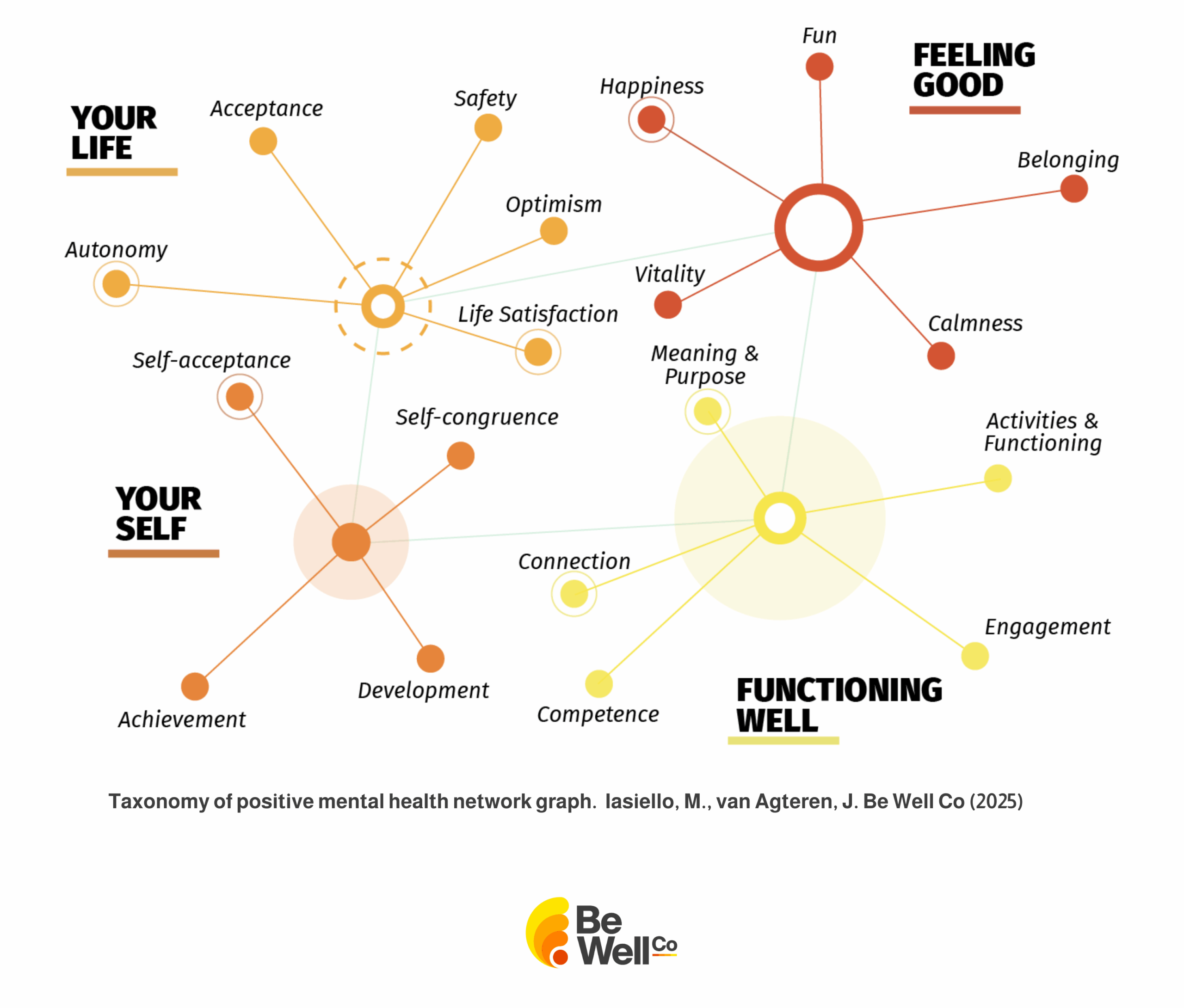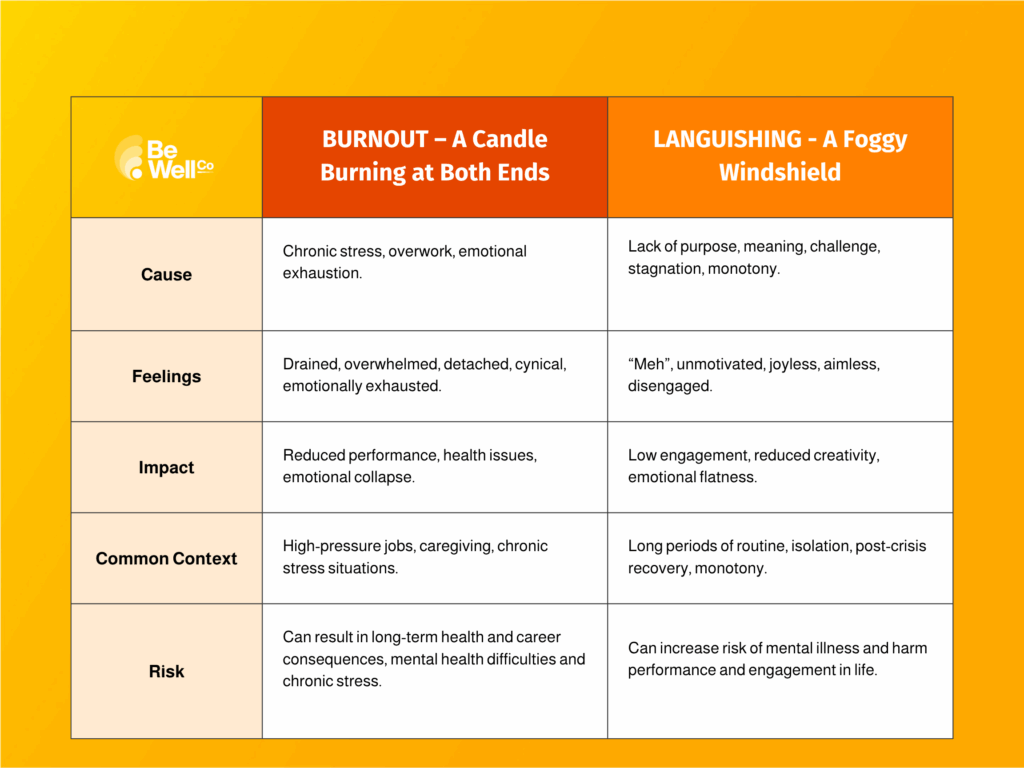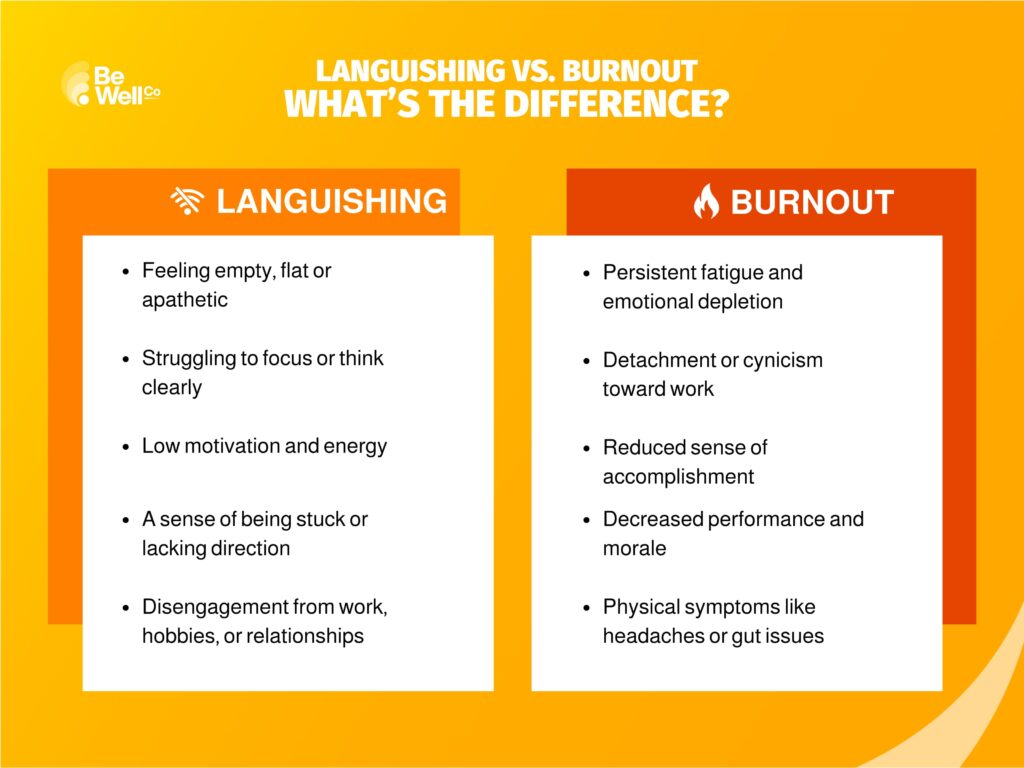What’s the difference?
We’ve all heard of burnout. It’s the feeling of being overwhelmed, exhausted, and emotionally drained, especially at work. Since the pandemic, another term has been talked about more, and it’s the focus of our work here at Be Well Co: languishing.
So what’s the difference between burnout and languishing? And why does it matter?
In this blog, we unpack the difference between languishing and burnout—two related but distinct experiences, and explore how understanding them can help us build healthier, more sustainable work lives.
What is languishing?
Languishing is a state of low mental wellbeing. It’s not depression or a mental health disorder, but it’s not thriving either. It’s that “blah” feeling. Like a foggy windshield, you’re moving, but you can’t see things clearly.
Often described as the middle child of mental health, languishing is marked by a lack of motivation, joy, and purpose. People who are languishing often say they’re just going through the motions, emotionally flat, and disconnected from what once gave them energy. Originally coined by Sociologist Corey Keyes that gained momentum following the COVID pandemic.
It’s not a clinical disorder, but it is a warning sign. Left unchecked, languishing can increase the risk of developing mental health problems down the track.
Signs of languishing
- Feeling empty, flat or apathetic
- Struggling to focus or think clearly
- Low motivation and energy
- A sense of being stuck or lacking direction
- Disengagement from work, hobbies, or relationships
What causes languishing?
Languishing tends to arise when life feels monotonous, isolating, or unchallenging. It’s often linked to:
- Lack of purpose or meaning
- Limited social connection
- Absence of personal growth
- Post-crisis recovery (e.g., post-lockdown fatigue)
In our recent survey, The Silent Impact of Languishing in Australian Workplaces, we found that employees experiencing languishing were:
- Less creative and innovative
- Less productive
- More withdrawn
- Less likely to engage in team or career development
- Increased presenteeism (showing up without being engaged)
Languishing at work might look like
- Losing motivation or creativity
- Reduced productivity
- Disconnection from team goals
- Less interest in career growth
- Withdrawing from colleagues
- Taking more sick or personal leave
What Is burnout?
Burnout is a state of chronic emotional and physical exhaustion that results from prolonged stress, most often in the workplace. It develops gradually, particularly in high-pressure jobs, caregiving roles, or environments with constant demands and little support.
If languishing is like a foggy windshield, burnout is like burning a candle at both ends.
Signs of burnout
- Persistent fatigue and emotional depletion
- Detachment or cynicism toward work
- Reduced sense of accomplishment
- Decreased performance and morale
- Physical symptoms like headaches or gut issues
What causes burnout?
Burnout typically results from prolonged workplace stress, overwhelm or emotional exhaustion. Factors include excessive workload, lack of control, insufficient reward, lack of community, absence of fairness, and value conflicts.
Effects of burnout
Burnout can lead to significant health problems, both mental and physical, and can severely impair professional and personal life. Burnout can lead to:
- Serious health issues—both mental and physical
- Emotional collapse or depression
- Absenteeism and decreased performance
- Job resignation or career change
- Reduced ability to connect with others or manage stress
Research shows that 1 in 20 workers completely check out after burnout—a reminder of just how serious and disruptive it can be.
In summary:
How are languishing and burnout connected?
While they’re different, languishing and burnout can influence one another.
The Cycle
Languishing → Burnout: Someone might feel unfulfilled and take on more tasks in search of meaning—only to become overwhelmed and burn out.
Burnout → Languishing: After burnout, if someone doesn’t recover properly, they may return to work feeling disengaged, disconnected, and aimless—entering a state of languishing.
How can we help prevent languishing and burnout?
Both languishing and burnout involve dissatisfaction and disengagement, but they stem from different causes. Fortunately, there are shared strategies that can support mental wellbeing and prevent both:
Set boundaries between work and life
Prioritise rest and recovery. Make sure you have clear time away from work, mentally and physically.
Engage in joy and creativity
When we invest all our energy in work, we become more vulnerable if things go wrong. Diversifying your sources of meaning through hobbies, relationships, or creative expression, helps us cope if some things are challenging.
Lean on supportive relationships
Build and invest in close connections. Reach out for support and ask for help if needed.
Burnout-specific support
- Seek workplace interventions or role changes- advocate for yourself and your needs
- Try and recognise early warning signs. Often burnout is a slow burn so try to check in with yourself regularly.
- Reduce workload or redistribute responsibilities – get support to reduce your load if it is too much.
- Advocate for fairer systems and better support
Languishing-specific support
- Reconnect with personal values and goals – highlight things that are important to you and that you like. Come back to your core desires for how you want your life to be, and see if there’s anything you can do differently to be on track with your goals
- Find ways to inject novelty or challenge into daily life – try a new activity, read a book, learn something you didn’t know, meet someone new, volunteer, go on a little trip if you can. Doing new things is good for us!
- Commit to action through hobbies, learning, or connection – ensure to engage with things you love regularly to make memories and have diverse and interesting weeks
What’s the difference between languishing and burnout?
- Languishing is low engagement and purpose, a foggy state that drains motivation and joy. Languishing leaves us “meh”, unmotivated, and emotionally dull.
- Burnout is severe emotional and physical response to chronic stress. It can affect our ability to function, harms our mental and physical health and can have a major impact on our personal and professional lives.
Languishing and burnout are distinct experiences, but both are important to recognise and address. By being aware of their signs, we can take steps individually to protect our own wellbeing—and collectively, we can create healthier systems. When we prioritise meaningful work, rest, connection, and support, we create environments where people can live well and feel well—both inside and outside of work.
Authors: Amy Smith – Chief Transformation Officer at Be Well Co & Esme Fabry – Knowledge and Translational Specialist at Be Well Co, Registered Psychologist
Want to Read More?
 Wellbeing, Workplace
Wellbeing, Workplace
Creating Psychologically Safe teams
Why Psychological Safety matters and how we build it together Based on Be Well Co’s “Psychological Safety for leaders” workshop Psychological safety has become one of the most important foundations of healthy, high-performing teams…. 18 Nov 2025 Wellbeing, Workplace
Wellbeing, Workplace
What does wellbeing that actually works (at work) look like?
Last week’s Fruit for Thought live in Adelaide: “Wellbeing that works across sectors” brought together leaders from finance, correctional services, and sport to unpack that question we all need to sit with. From the… 14 Oct 2025 3 min read Wellbeing
Wellbeing






